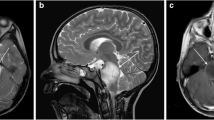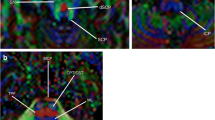Summary
Ten normal human volunteers and 44 patients with pathology of the brainstem or cranial nerves were scanned using a. 3 Tesla permanent MR imaging system. MR images were obtained of the cranial nerves and brainstem using various spin-echo pulse sequences and scanning planes. 4 mm thick sections with .75 mm pixels on a 256 display matrix were used whenever possible. The normal MR images were correlated with thin section cryodissection specimens of fresh human cadavers. Brainstem structures including major nuclei and tracts were then identified. The cranial nerves were followed through the subarachnoid cisterns and the base of the skull. Pathological involvement of the brainstem by tumors, infarcts, and demyelinating disease was well shown and correlated with clinical findings. Examples of optic glioma, fifth, eighth, and twelth nerve schwannomas as well as other cranial nerve pathology were also demonstrated. Magnetic resonance produces excellent images of cranial nerves and brainstem with high contrast resolution. Unlike CT, there is no beam hardening artifact from bone. T1 weighted images maximize brainstem-CSF contrast and are useful for demonstrating the external anatomy of the brainstem and cranial nerves. The T2 weighted images show internal brainstem anatomy, CSF within neural foramina, and highlight many pathological conditions.
Résumé
Dix volontaires ayant un tronc cérébral et des nerfs crâniens normaux et 44 patients, présentant des lésions pathologiques de la région ont été explorés en résonance magnétique avec un système permanent. 3 Tesla. Les images des nerfs crâniens et du tronc cérébral ont été obtenues par couples multiples en spin-écho dans des plans différents. Des sections de 4 mm avec des pixels de 0,75×0,75 sur une matrice de 256×256 ont été réalisées chaque fois que c'était possible. La comparaison des images normales et pathologiques en résonance magnétique a été également effectuée avec des cryodissections de spécimens. Les structures du tronc cérébral comprenant les principaux noyaux ont pu ainsi être identifiées; le trajet des nerfs crâniens a été suivi à travers les citernes sous-arachnoïdiennes et la base du crâne. Les altérations pathologiques du tronc cérébral, tumeurs, infarctus, lésions démyélinisantes ont été visualisées et la corrélation avec les tableaux cliniques effectuée. Des images de gliomes optiques, de schwannomes des 5c, 8c et 12c nerfs ainsi que d'autres lésions des nerfs crâniens ont également été obtenues. La résonance magnétique donne d'excellentes images des nerfs crâniens et du tronc cérébral avec une résolution de contrastes. A la différence de la tomodensitométrie, il n'y a pas d'artéfact à partir de l'os. Le T1 utilisé a bien mis en évidence le contraste cerveau/liquide céphalorachidien permettant la visualisation optimale de l'anatomie morphologique du tronc cérébral et des nerfs crâniens. Le T2 permet de voir les structures internes du tronc cérébral, le liquide céphalo-rachidien au niveau des orifices osseux et apportent le diagnostic de nombreuses lésions pathologiques.
Similar content being viewed by others
References
Steele JR, Hoffman JC (1980) Brainstem evaluation with CT cistemography. AJNR, 1: 521–526
Glanz S, Geehr RB, Duncan CC, Smith S (1980) Metrizamide-enhanced CT for evaluation of brainstem tumors. AJNR 1: 31–34.
Maward ME, Silver AJ, Hital SK, Ganti SR (1983) Computed tomography of the brainstem with intrathecal metrizamide. Part 1: The normal brainstem. AJNR, 4: 1–11
Maward ME, Silver AJ, Hilak SK, Ganti SR (1983) Computed tomography of the brainstem with intrathecal metrizamide. Part II: Lesions in and around the brainstem. AJNR, 4: 13–19
Johnson DW (1984) Air cisternography of the cerbellopontine angle using high resolution computed tomography. Radiology, 151: 401–403
Chakeres DW, Kapila A (1983) Brainstem and related structures: Normal CT anatomy using direct longitudinal scanning with metrizamide cisternography. Radiology, 149: 709–715
Han JS, Bonstelle CT, Kaufman B, Benson JE, Alfidi R, Clampitt M, Van Dyke C, Huss R (1984) Magnetic resonance imaging in the evaluation of the brainstem. Radiology, 150: 705–712
Flannigan BD, Bradley Jr WG, Lufkin R, Bentson J, Wilson G, Hanafee W (1985) Magnetic resonance imaging of the brainstem: normal structure and basic function. Radiology, 154: 375–383
Lufkin R, Votruba J, Reicher M, Basset L, Smith S, Hanafee W (1986) Solenoid surface coils in MRI. AJR (in press)
Rauschning W, Bergstrom K, Pech P (1983) Correlative craniospinal anatomy studies by computed tomography and cryomicrotomy. J Cat, 7: 9–13
Daniels D, Rauschning W, Lovas J, Williams A, Haughton V (1983) Pterygopalatine fossa: Computed tomographic studies. Radiology, 149: 511–516
Author information
Authors and Affiliations
Rights and permissions
About this article
Cite this article
Lufkin, R., Flannigan, B.D., Bentson, J.R. et al. Magnetic resonance imaging of the brainstem and cranial nerves. Surg Radiol Anat 8, 49–66 (1986). https://doi.org/10.1007/BF02539708
Issue Date:
DOI: https://doi.org/10.1007/BF02539708




